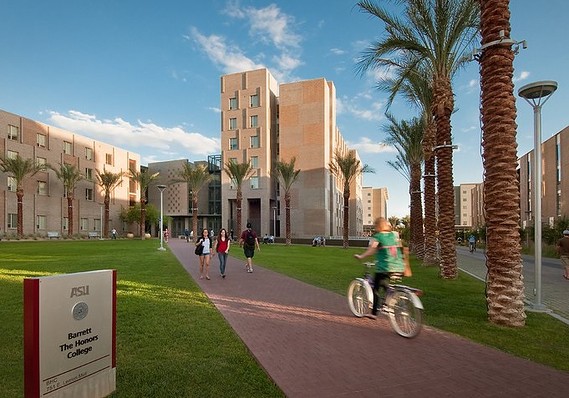(Corrects the first name of Macaulay Dean Mary C. Pearl.)
 Barrett Honors College
Barrett Honors College
Degrees from the nation’s most selective colleges are so coveted, some parents will lie, cheat and steal their way in while others put their kids deep into debt to get those bragging rights.
But for people who want to give their kids a great education at a decent price, honors colleges of state universities are a terrific alternative.
These are usually small, autonomous colleges within state universities, are more selective than their parent institutions, often have separate study programs, and have much lower student/faculty ratios. In-state students pay much lower tuition — in some cases, none at all, while even out-of-state students can get aid at some of the schools. (Families can also get great deals at elite universities, which, according to U.S. News and World Report, offer discounts as high as 70% off list price, but your kid has to get in first.)
As of last April, the website publicuniversityhonors.com, which ranks honors colleges, named Barrett, the Honors College at Arizona State University; Macaulay Honors College at City University of New York (CUNY), and honors colleges from Florida Atlantic, Kansas, Penn State and UT Austin as the best in the nation.
But many other state universities have excellent honors colleges, and parents and high-school students should definitely put them on their lists. I spoke with the deans of Barrett and Macaulay to find out what makes those schools tick.
Top-quality colleges
“Our goal is to transform the lives of some of the brightest students so that they can achieve far beyond what they imagined possible,” Macaulay Dean Mary C. Pearl told me. “It’s essentially a top-quality liberal arts college embedded in a big city university.”
And not just any big-city university. CUNY, which includes City College, Hunter, Queens, Brooklyn and Baruch, has been for generations a stepping stone for immigrant and working-class families into the middle class and the professions. Some 18% of Macaulay’s 2,131 students were the first in their families to go to college, and 56% came from New York City public high schools. (Macaulay admits students from all over New York state but the vast majority of students live at home in the city.)
The school gives its students, who take classes on the separate CUNY campuses and at Macaulay headquarters in Manhattan, lots of advising, and not only on academics.
“No one falls between the cracks,” says Pearl. Students go on to top graduate and professional schools and Macaulay has produced four Rhodes scholars and 37 Fulbright Fellows. Alumni work at leading New York City corporations.
And the cost of all this, with special grants and aid, can come to almost nothing: 87% of students graduate debt-free, the school says. No need for Sens. Bernie Sanders or Elizabeth Warren to bail them out!
Dean Mark Jacobs was recruited to run Barrett in 2003 because he had deep experience at a small liberal arts college, Swarthmore (my alma mater, by the way). Barrett may be the nation’s largest honors college, with over 7,000 students, the vast majority at ASU’s sprawling Tempe campus, which has more than 50,000 students. ASU, of course, is best known as a Pac-12 Division 1 power whose stellar former athletes include Houston Rocket James Harden, golfer Phil Mickelson and Baseball Hall of Famer Reggie Jackson.
Diverse student population
Barrett students, however, are as nerdy as you get. They’re also likely to come from families of modest incomes, and 30% are the first in their families to attend college. Given Arizona’s demographics — it was more than 30% Hispanic in the 2010 Census — Barrett is quite diverse as well, with 42% students of color.
“They were just a completely underserved population,” Jacobs told me. “They came to public universities, they were great students, but they weren’t really pushed or challenged as much as they easily could have been.” Barrett does that, but with lots of counseling and support as well.
The proof is in the outcomes — in prestigious fellowships and admission to top graduate and professional schools like Stanford, Columbia, Duke, and NYU Law. Half the graduates work for employers that include Amazon AMZN, -1.35%, Intel INTC, -1.44% (the school is named for former CEO Craig Barrett and his wife, ASU grad Barbara) and Goldman Sachs GS, -0.92%.
“It’s very easy to show parents … that their kid has the same options as an Ivy grad, and they’re coming here for either half the price if it’s an out-of-state student, or a third the price if it’s an in-state students,” said Jacobs.
Small price tag
Two things are unusual about Barrett: Much of the financial aid is merit-based (though there’s need-based aid as well), driving the actual price down to $10,000-$11,000 a year, Jacobs said. And out-of-state students comprise 35% of enrollment, and they get generous aid, too. No wonder applications have been growing by 15% a year.
“It’s just a smoking deal,” said Jacobs, sounding more like a salesman than a tweedy academic. But he’s right: Honors colleges of state universities are a “smoking deal” — the best you can get in higher education today.
Howard R. Gold is a MarketWatch columnist. Follow him on Twitter @howardrgold. No-Nonsense College runs monthly. Please send ideas to [email protected].





